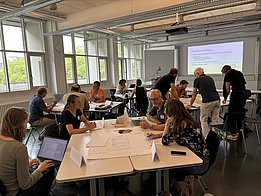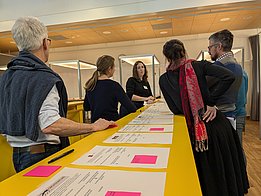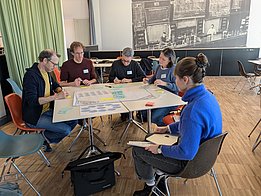
Habitat connectivity & ecological infrastructure (completed) ¶
How can connectivity measures (stepping stone distances, arrangement of connectivity elements, avoidance of barriers, European migration corridors, etc.) be implemented most effectively overall, and for guilds and specific species? Which measures can be used to implement ecological infrastructure (EI) across sectoral policies at the cantonal level?
The Habitat Connectivity and Ecological Infrastructure working group analysed the ecological and regulatory barriers to habitat connectivity in Switzerland and identified effective measures to overcome them. This broad topic required diverse perspectives and consisted of over 30 experts from research, cantonal and municipal governance, nature protection, environmental consulting, and law. Our work was divided into two, thematic sub-groups:
In the ‘ecology’ subgroup, we focused on man-made, physical barriers on the landscape, such as roads, railways, dams, and expanding settlements, discussing their effects on biodiversity due to habitat fragmentation. We sought examples of successful approaches for mitigating these barriers in Switzerland and beyond, including creating stepping stone habitats, species passageways, and river revitalisation. We developed a consolidated knowledge base report summarising our knowledge and findings. Following this work, we discussed difficulties faced by nature protection officers and environmental consultants when using spatial modelling frameworks and software to create habitat connectivity plans. From these discussions, we developed a practitioner guide on spatial modelling, which includes an overview of approaches, software recommendations, a resource compilation, and a dataset containing dispersal distances and home range sizes for Swiss indicator species.
In the ‘Policy’ subgroup, we focused on the cross sectoral implementation of EI at cantonal level. To this end, we selected seven sectors relevant to EI for the first report. The regulatory framework for each sector is summarised in a table. We also compiled a list of measures used in these sectors to implement EI. In this context, we looked at various resources that are essential for the successful implementation of EI-projects. In a follow-up report, we examine cross sectoral coordination at federal level (also known as Mainstreaming), for which we have summarised the results of an analysis of federal documents from various sectors on the problems and solutions described therein in relation to EI. Both reports serve to provide an overview of the realities of other sectors in implementing EI and to encourage increased cross sectoral cooperation.
The working group meetings ran between May and November 2024. The reports are expected to be published from the end of November 2025.


